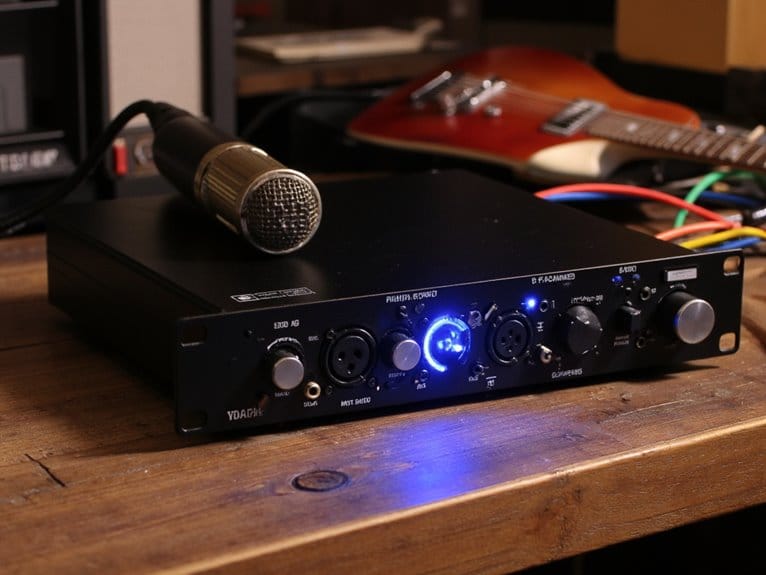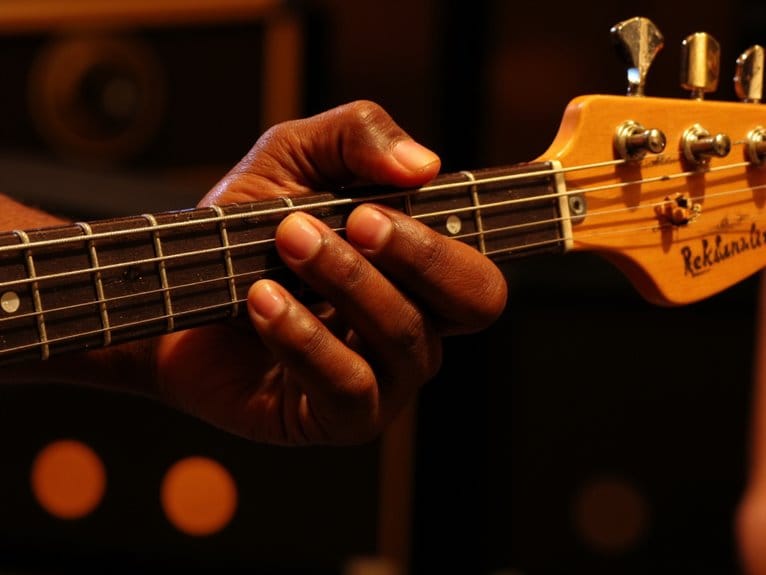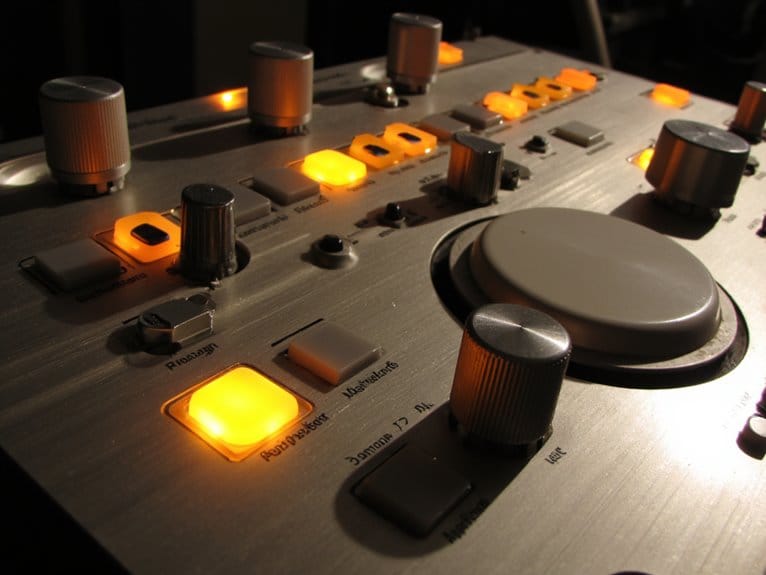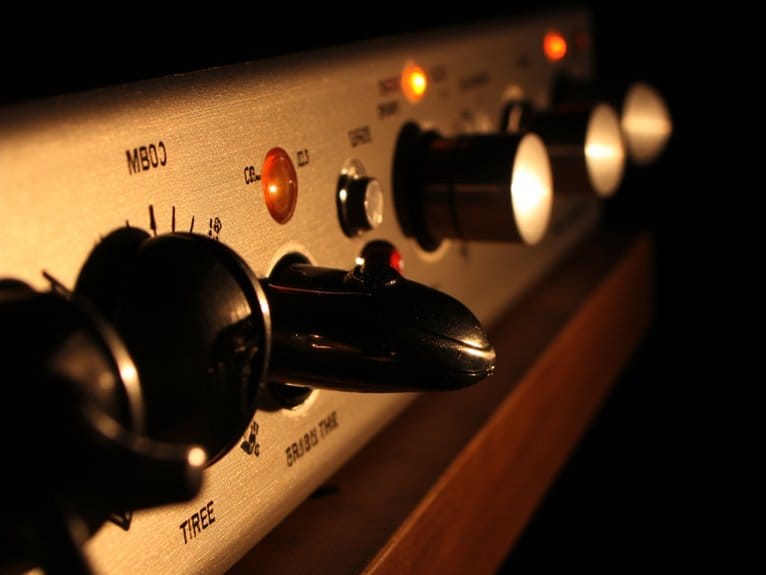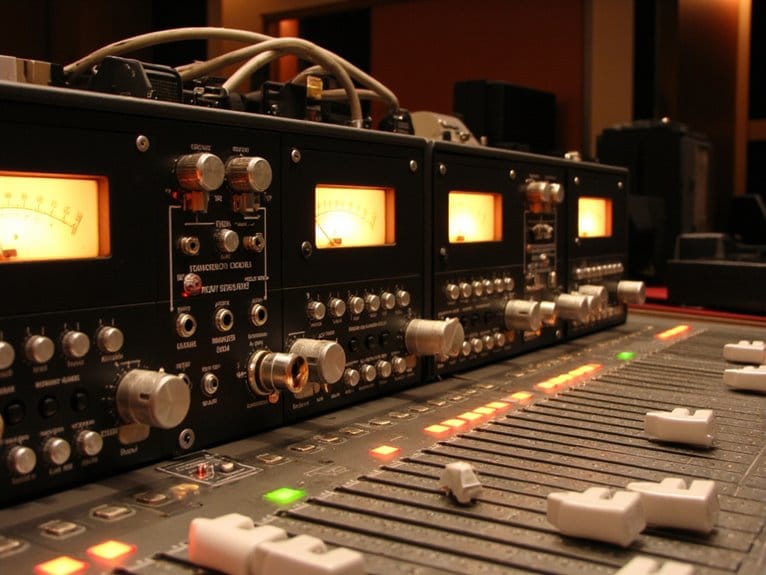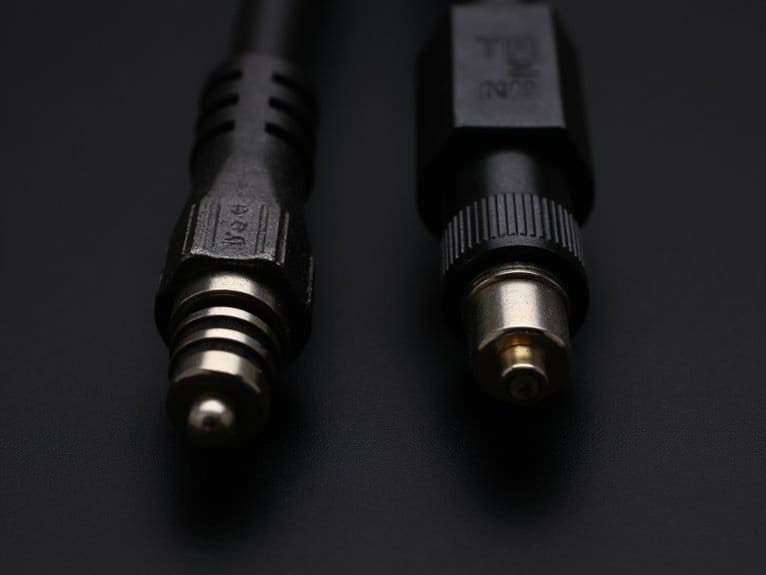What Is an Audio Interface and How Does It Work
An audio interface acts as your essential bridge between analog instruments, microphones, and your computer’s digital recording environment. It converts analog sound waves into digital data through high-quality analog-to-digital converters, while simultaneously handling playback through digital-to-analog conversion. You’ll get superior 24-bit recording quality, phantom power for condenser mics, and multiple input options including XLR and Hi-Z connections. Understanding these fundamentals opens the door to exploring advanced features and selecting the perfect interface for your specific recording needs.
We are supported by our audience. When you purchase through links on our site, we may earn an affiliate commission, at no extra cost for you. Learn more.
Notable Insights
- Audio interfaces bridge analog instruments and microphones to computers by converting signals between analog and digital formats.
- They use ADCs to convert analog audio into digital data and DACs to convert digital audio back to analog.
- Built-in preamps boost weak microphone signals to usable levels while providing phantom power for condenser microphones.
- Multiple connection types including XLR, Hi-Z, and combo jacks accommodate various instruments and recording equipment simultaneously.
- They enable high-quality multi-track recording with 24-bit resolution, superior to built-in computer audio systems.
Understanding Audio Interface Fundamentals
When you’re diving into digital audio production, the audio interface serves as the crucial bridge between your analog instruments and microphones and your computer’s digital recording environment. Fundamentally, it’s the translator that converts your analog audio signals into digital data through analog-to-digital converters, while simultaneously handling digital audio routing back to your speakers and headphones via digital-to-analog converters.
The magic happens through sophisticated audio signal processing, where built-in preamps first amplify weak microphone signals to ideal levels. Then ADCs transform these analog waveforms into digital information your computer can manipulate. This capability becomes essential when you need to record multiple channels simultaneously, particularly in complex studio setups with several microphones. Professional interfaces typically deliver 24-bit/192kHz resolution to ensure superior audio fidelity and minimal noise during recordings.
During playback, the interface reverses this process, converting processed digital audio back to analog signals you can actually hear through your monitoring system. Many interfaces also include direct monitoring, which allows you to hear your input signal in real-time without the delay that occurs when audio travels through your computer’s processing chain. Quality audio interfaces feature ultra-low-noise preamps that can provide significant gain while maintaining clean signal reproduction.
Core Functions That Make Audio Interfaces Essential
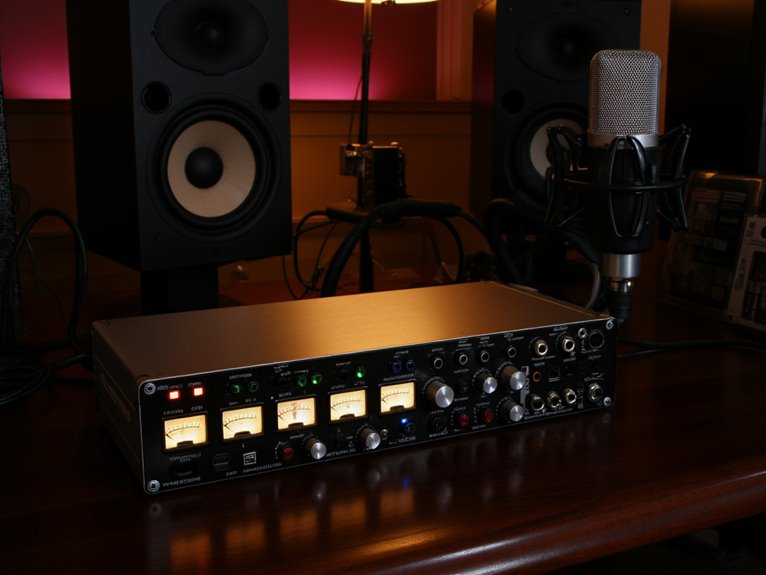
Now that we’ve established how audio interfaces function as signal converters, let’s examine the specific capabilities that make them indispensable tools in any serious recording setup.
You’ll find that audio quality depends heavily on the analog-to-digital conversion process, which transforms your microphone’s electrical signals into digital data your computer can process. The most vital function involves signal processing through high-quality preamps, which boost weak audio signals to ideal recording levels while maintaining a low noise floor.
Your interface’s digital-to-analog conversion guarantees accurate playback through monitors or headphones, creating the essential feedback loop for real-time monitoring. Modern audio interfaces also provide interface expansion capabilities, offering multiple inputs and outputs that allow you to connect various audio devices simultaneously for more complex recording configurations.
Digital-to-analog conversion delivers precise playback through monitors and headphones, establishing the crucial real-time monitoring feedback loop for professional recording.
Professional interfaces include phantom power support at 48V, enabling you to use condenser microphones that significantly improve audio capture quality. These core functions work together seamlessly, providing the foundation for professional recordings, whether you’re capturing vocals, instruments, or producing podcasts with crystal-clear audio fidelity. Quality audio interfaces minimize latency delays during recording and playback, ensuring synchronized audio performance.
Most professional recording setups prioritize 24-bit resolution and 96 kHz sampling rates as the minimum standard for capturing studio-quality audio.
Key Components and Technical Features
When you’re examining audio interfaces, you’ll find that three fundamental components determine how well your device captures, processes, and delivers sound to your recording setup.
The preamps and gain control circuits boost your microphone signals to usable levels, while the analog-to-digital converters (ADCs) and digital-to-analog converters (DACs) handle the critical translation between the analog world of sound waves and your computer’s digital domain. Professional interfaces often feature 24-bit recording capabilities that ensure studio-grade audio quality for both home and commercial recording applications. High-quality preamps with features like switchable Air mode can enhance the clarity and brightness of your recordings, particularly when capturing vocals and acoustic instruments.
Your choice of input and output connection types, from XLR microphone inputs to line outputs and digital connectivity options, ultimately shapes how many instruments you can record simultaneously and how you’ll integrate the interface into your studio workflow. Audio interfaces connect to your computer through various options including USB, Thunderbolt, Firewire, or ethernet ports, with each connection type offering different advantages for data transfer speed and latency performance. Many modern interfaces also serve as the foundation for sub-bass frequency processing in genres like hip-hop and electronic music, where deep low-end content requires specialized handling during the recording and monitoring chain.
Preamps and Gain Control
Two critical components sit at the heart of every quality audio interface: the preamps that transform your whispered vocals and delicate guitar fingerpicking into robust signals, and the gain controls that let you dial in just the right amount of amplification without turning your recording into a distorted mess.
Quality preamps, like those found in PreSonus XMAX and Focusrite Scarlett series, provide 40-60 dB of clean amplification while maintaining low noise floors that won’t sabotage your recordings. When working with different source volumes, you’ll need to match your microphone sensitivity accordingly—using sensitive microphones for quieter sources and less sensitive ones for louder performances to prevent gain staging complications.
The gain optimization process requires finding that sweet spot between one and four o’clock on your potentiometer, where you’re maximizing signal strength without introducing unwanted distortion. I’ve learned that trusting your ears over visual meters leads to better results, since proper gain staging preserves your audio’s dynamic range and guarantees professional-quality captures every time. Many interfaces include phantom power support, which is essential when using condenser microphones that require this 48-volt power source to function properly.
ADC and DAC Converters
While preamps shape your signal’s initial strength, the ADC and DAC converters handle the critical transformation between the analog world of microphones and instruments and the digital domain where your computer processes audio.
ADC technology converts your analog signals into digital data that your computer can process, while DAC performance determines how accurately that digital information becomes analog sound again through your monitors or headphones.
Modern converters operate at sampling rates from 44.1 kHz to 192 kHz with 24-bit depth, maintaining professional-grade fidelity. These converters essentially bridge external gear with your computer’s digital recording environment.
Here’s what makes quality converters crucial:
- Dynamic range reaching 118 dB preserves subtle details and prevents noise
- Multiple input channels enable simultaneous recording with precise timing
- Differential analog outputs reduce distortion and electromagnetic interference
- Programmable gain control provides precise level adjustments digitally
- Support for various digital formats guarantees compatibility across different systems
Input/Output Connection Types
Your audio interface’s connection types determine which equipment you can plug in, how many tracks you’ll record simultaneously, and ultimately whether your setup handles bedroom demos or full band sessions with professional fidelity.
Input types range from XLR connectors for microphones to Hi-Z inputs for guitars, while combo jacks provide interface flexibility by accepting multiple connector types.
Output types include balanced XLR outputs for studio monitors and headphone jacks for personal monitoring, each affecting audio quality differently.
Signal integrity depends heavily on your cable choices and proper impedance matching between audio sources.
I’ve learned that compatibility issues often arise when mixing consumer RCA connectors with professional gear, so understanding device integration requirements prevents frustrating troubleshooting sessions during critical recording moments. Digital connections like ADAT optical enable expansion of your interface’s channel count by linking external converters and preamps.
Connection Types and Input/Output Options
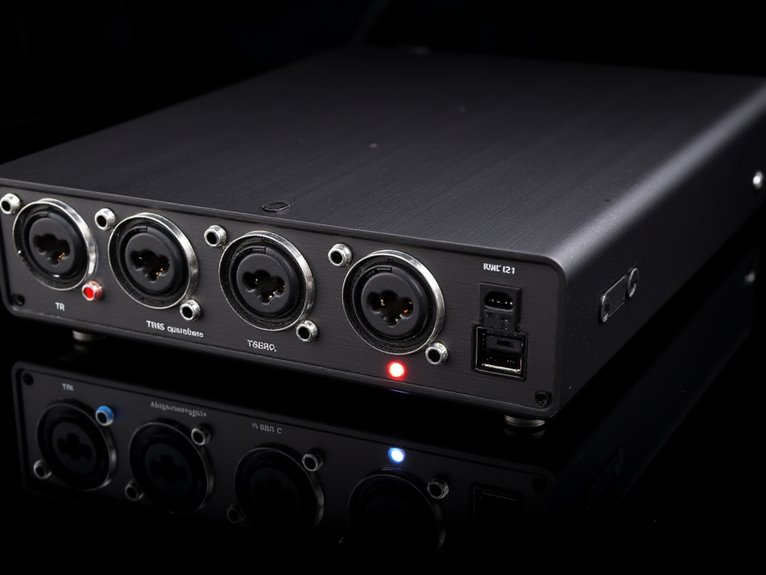
Five primary connection types dominate the audio interface landscape, each offering distinct advantages depending on your studio setup, budget, and performance requirements.
When you’re selecting audio interface technology, understanding these connection options becomes essential for optimizing your digital signal processing workflow:
- USB remains the most versatile choice, offering excellent compatibility across platforms with reliable transfer speeds for most home studios.
- Thunderbolt delivers superior data rates and minimal latency, making it ideal for professional environments requiring high channel counts.
- USB-C provides faster speeds than traditional USB with convenient reversible connectors, increasingly common in newer interfaces.
- FireWire represents older technology that’s largely obsolete, though some legacy systems still utilize these connections.
- Optical connections expand your I/O capabilities through ADAT protocols, allowing seamless integration with external preamps and converters for enhanced recording flexibility.
Role in Modern Recording and Music Production
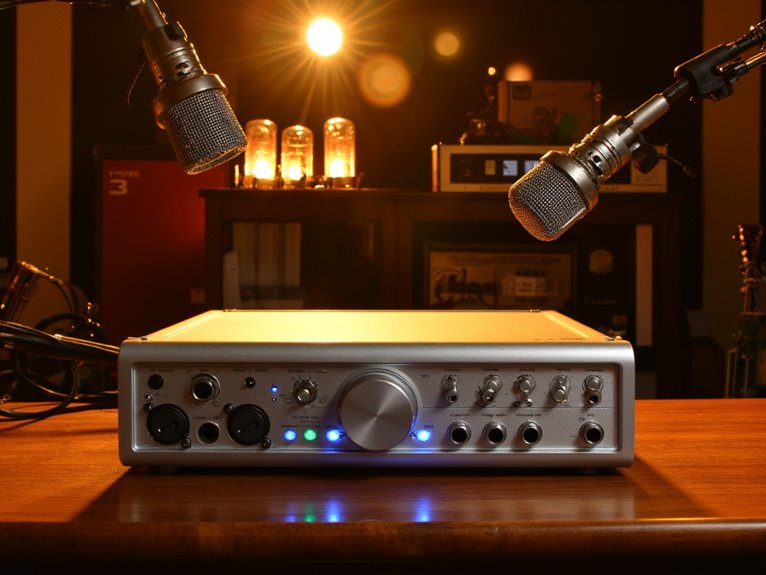
The backbone of contemporary music creation, audio interfaces have fundamentally transformed how we approach recording and production in both professional studios and bedroom setups.
You’ll find that interface versatility enables everything from solo vocal recordings to full band sessions, supporting multiple simultaneous tracks while maintaining professional signal quality that far exceeds your computer’s built-in sound card.
Modern connectivity options like USB, Thunderbolt, and FireWire guarantee efficient data transfer with ultra-low latency, making real-time monitoring seamless during recording sessions.
I’ve observed how these devices democratize music production, allowing amateur musicians to achieve professional results at home while providing the scalability that seasoned engineers require for complex studio work.
Today’s interfaces feature ultralow-noise preamps and high-resolution capabilities up to 24-bit/192 kHz, ensuring pristine audio capture that meets professional studio standards.
Professional interfaces deliver +60 dB gain specifically designed for low-output dynamic microphones, ensuring optimal performance across diverse recording applications.
Selecting the Perfect Audio Interface for Your Needs
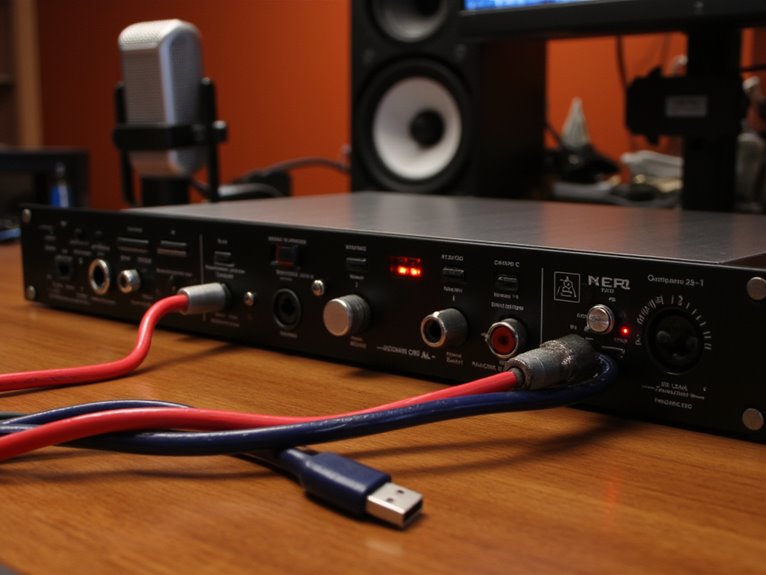
When you’re ready to choose your audio interface, I recommend starting with an honest assessment of your input requirements, since buying a 16-channel unit when you’ll only ever record vocals and guitar simultaneously represents both wasted money and unnecessary complexity.
You’ll need to strike that delicate balance between your available budget and the quality level your projects demand, because while a $50 interface might seem tempting, it could introduce noise floors and latency issues that’ll frustrate you more than my first attempt at home recording did years ago.
The key lies in matching your interface’s capabilities to your actual workflow, rather than purchasing based on aspirational features you may never use, though I’d always suggest leaving some room for growth in your decision.
For example, PreSonus offers models ranging from the ultra-portable AudioBox GO for basic recording needs to the expandable Studio 1824c that supports up to 18 simultaneous inputs, allowing you to find an interface that matches your current requirements while providing options for zero-latency monitoring and professional-grade preamps. Additionally, consider that Thunderbolt interfaces generally provide lower latency compared to USB interfaces, which can be crucial for professional recording applications where timing precision matters most.
Assess Your Input Requirements
Before diving into specific audio interface models, I’ve learned that accurately evaluating your input requirements forms the foundation of making a smart purchase decision. Understanding your current recording scenarios, along with potential future expansion, helps determine the ideal input types and input quantity you’ll need.
Consider these key factors when reviewing your setup:
- Input quantity: Solo artists need 1-2 inputs, while bands require 4-8+ for simultaneous recording.
- Connectivity options: XLR for mics with phantom power, 1/4″ for instruments, MIDI for keyboards.
- Preamp requirements: Built-in preamps with adequate gain levels eliminate external gear needs.
- Input types: Balanced XLR/line inputs versus high-impedance instrument inputs for optimal signal transfer.
- Future scalability: ADAT expansion capabilities allow adding external preamps later without interface replacement.
Budget and Quality Balance
After pinpointing your input requirements, you’ll quickly discover that finding the sweet spot between your budget constraints and desired audio quality represents one of the most challenging aspects of interface selection.
Budget models around $40-$50, like the Behringer UMC22, provide functional performance but often sacrifice sound clarity through lower-quality preamps and converters. Mid-range options between $120-$200 demonstrate significant improvements in audio fidelity, featuring Midas preamps and enhanced analog circuitry that dramatically reduce noise floors.
Premium devices above $200 deliver exceptional converters and professional-grade components, though diminishing returns become apparent. Through careful cost comparison, you’ll find that investing slightly more than rock-bottom pricing typically yields substantial quality improvements, making mid-tier interfaces the finest choice for most users seeking professional results without breaking the bank.
Common Audio Interface Applications and Use Cases

Audio interfaces have transformed from niche studio equipment into versatile tools that power everything from bedroom recording sessions to professional broadcast facilities. I’ve witnessed this evolution firsthand across countless creative environments.
Audio interfaces have evolved from expensive studio gear into accessible creative tools that democratize professional-quality recording for everyone.
These Audio Interface Applications span diverse Use Case Scenarios that’ll likely surprise you:
- Home Recording Studios – You’ll connect microphones and instruments directly to your computer, with built-in preamps delivering clean, professional audio for songwriting and vocal tracking.
- Live Performance Setups – DJs and musicians rely on low-latency playback for virtual instruments, backing tracks, and seamless audio routing between headphones and main outputs.
- Podcasting Operations – Multiple microphone inputs enable panel discussions while improving vocal clarity and reducing background noise for broadcast-quality sound.
- Content Creation Workflows – YouTubers and streamers achieve crystal-clear audio input that far surpasses built-in computer microphones.
- Professional Studio Engineering – High-fidelity conversion supports multi-track recording with dozens of inputs for large-scale production sessions.
Frequently Asked Questions
Can I Use Multiple Audio Interfaces Simultaneously on One Computer?
You can use multiple audio interfaces simultaneously, though you’ll face compatibility concerns since different manufacturers often require separate drivers that don’t always play nicely together.
Performance limitations include increased latency and higher CPU usage, which I’ve experienced firsthand in complex setups.
Software solutions like ASIO4ALL or your operating system’s aggregate device feature can bridge these interfaces, but expect some technical troubleshooting during initial configuration.
Do Audio Interfaces Work With Tablets and Smartphones?
Yes, you’ll find that audio interface compatibility with modern tablets and smartphones works quite well, though I’ve noticed Android devices like Samsung’s Galaxy Tab require class-compliant interfaces for reliable tablet connection.
Your iOS devices typically offer broader app support, while Android compatibility varies considerably depending on your specific hardware, drivers, and music production apps like Cubasis, making manufacturer-certified options your safest choice.
What’s the Difference Between USB 2.0 and USB 3.0 Interfaces?
The main difference you’ll notice between USB 2.0 and USB 3.0 interfaces comes down to USB speed and data transfer capabilities, where USB 3.0 operates at 5 Gbps compared to USB 2.0’s 480 Mbps.
You’ll experience lower latency, better multichannel support, and improved power delivery with USB 3.0, though you’ll pay more for these enhanced features.
How Do I Fix Audio Interface Driver Issues and Conflicts?
When you’re facing audio interface driver issues, I’d recommend starting with complete driver uninstallation through Device Manager.
Then performing a clean driver installation using the manufacturer’s latest files.
Your troubleshooting steps should include testing different USB ports, checking for Windows conflicts, updating your operating system, and verifying DAW audio settings to guarantee proper interface recognition and functionality.
Can Audio Interfaces Improve Sound Quality for Regular Music Listening?
Yes, you’ll definitely notice improved audio clarity when using a quality audio interface for regular music listening, as they feature superior DACs and headphone amplifiers compared to standard computer outputs.
Your listening experience becomes markedly cleaner with reduced distortion, better dynamic range, and enhanced detail retrieval.
I’ve found that even mid-range interfaces like the Focusrite Scarlett series provide noticeable improvements over built-in audio.
On a final note
You’ve now got the essential knowledge to make an informed audio interface decision, whether you’re tracking vocals in your bedroom studio, streaming to thousands of viewers, or producing professional podcast content. Remember, the best interface isn’t necessarily the most expensive one, but rather the unit that matches your specific input requirements, budget constraints, and long-term creative goals. Start with your current needs, then expand as your skills develop.

